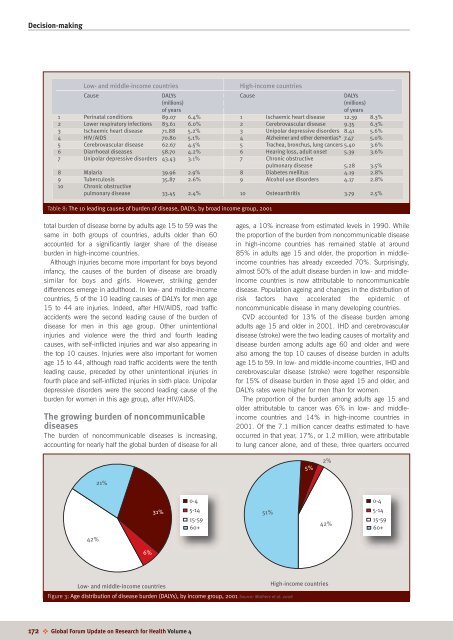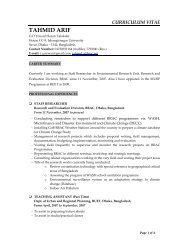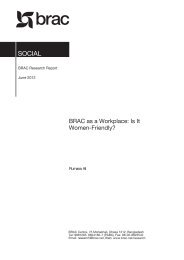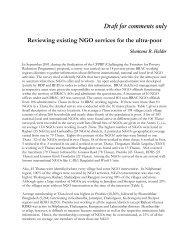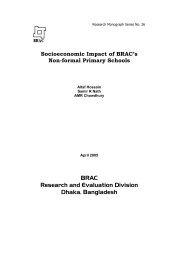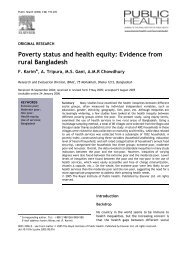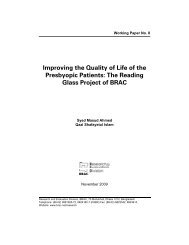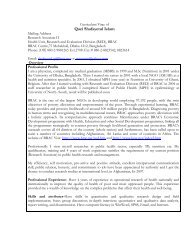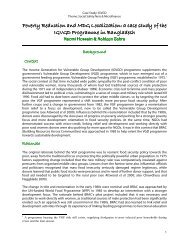Combining health and social protection measures to reach the ultra ...
Combining health and social protection measures to reach the ultra ...
Combining health and social protection measures to reach the ultra ...
You also want an ePaper? Increase the reach of your titles
YUMPU automatically turns print PDFs into web optimized ePapers that Google loves.
Decision-making<br />
Low- <strong>and</strong> middle-income countries<br />
High-income countries<br />
Cause DALYs Cause DALYs<br />
(millions) (millions)<br />
of years<br />
of years<br />
1 Perinatal conditions 89.07 6.4% 1 Ischaemic heart disease 12.39 8.3%<br />
2 Lower respira<strong>to</strong>ry infections 83.61 6.0% 2 Cerebrovascular disease 9.35 6.3%<br />
3 Ischaemic heart disease 71.88 5.2% 3 Unipolar depressive disorders 8.41 5.6%<br />
4 HIV/AIDS 70.80 5.1% 4 Alzheimer <strong>and</strong> o<strong>the</strong>r dementias* 7.47 5.0%<br />
5 Cerebrovascular disease 62.67 4.5% 5 Trachea, bronchus, lung cancers 5.40 3.6%<br />
6 Diarrhoeal diseases 58.70 4.2% 6 Hearing loss, adult onset 5.39 3.6%<br />
7 Unipolar depressive disorders 43.43 3.1% 7 Chronic obstructive<br />
pulmonary disease 5.28 3.5%<br />
8 Malaria 39.96 2.9% 8 Diabetes mellitus 4.19 2.8%<br />
9 Tuberculosis 35.87 2.6% 9 Alcohol use disorders 4.17 2.8%<br />
10 Chronic obstructive<br />
pulmonary disease 33.45 2.4% 10 Osteoarthritis 3.79 2.5%<br />
Table 8: The 10 leading causes of burden of disease, DALYs, by broad income group, 2001<br />
<strong>to</strong>tal burden of disease borne by adults age 15 <strong>to</strong> 59 was <strong>the</strong><br />
same in both groups of countries, adults older than 60<br />
accounted for a significantly larger share of <strong>the</strong> disease<br />
burden in high-income countries.<br />
Although injuries become more important for boys beyond<br />
infancy, <strong>the</strong> causes of <strong>the</strong> burden of disease are broadly<br />
similar for boys <strong>and</strong> girls. However, striking gender<br />
differences emerge in adulthood. In low- <strong>and</strong> middle-income<br />
countries, 5 of <strong>the</strong> 10 leading causes of DALYs for men age<br />
15 <strong>to</strong> 44 are injuries. Indeed, after HIV/AIDS, road traffic<br />
accidents were <strong>the</strong> second leading cause of <strong>the</strong> burden of<br />
disease for men in this age group. O<strong>the</strong>r unintentional<br />
injuries <strong>and</strong> violence were <strong>the</strong> third <strong>and</strong> fourth leading<br />
causes, with self-inflicted injuries <strong>and</strong> war also appearing in<br />
<strong>the</strong> <strong>to</strong>p 10 causes. Injuries were also important for women<br />
age 15 <strong>to</strong> 44, although road traffic accidents were <strong>the</strong> tenth<br />
leading cause, preceded by o<strong>the</strong>r unintentional injuries in<br />
fourth place <strong>and</strong> self-inflicted injuries in sixth place. Unipolar<br />
depressive disorders were <strong>the</strong> second leading cause of <strong>the</strong><br />
burden for women in this age group, after HIV/AIDS.<br />
The growing burden of noncommunicable<br />
diseases<br />
The burden of noncommunicable diseases is increasing,<br />
accounting for nearly half <strong>the</strong> global burden of disease for all<br />
ages, a 10% increase from estimated levels in 1990. While<br />
<strong>the</strong> proportion of <strong>the</strong> burden from noncommunicable disease<br />
in high-income countries has remained stable at around<br />
85% in adults age 15 <strong>and</strong> older, <strong>the</strong> proportion in middleincome<br />
countries has already exceeded 70%. Surprisingly,<br />
almost 50% of <strong>the</strong> adult disease burden in low- <strong>and</strong> middleincome<br />
countries is now attributable <strong>to</strong> noncommunicable<br />
disease. Population ageing <strong>and</strong> changes in <strong>the</strong> distribution of<br />
risk fac<strong>to</strong>rs have accelerated <strong>the</strong> epidemic of<br />
noncommunicable disease in many developing countries.<br />
CVD accounted for 13% of <strong>the</strong> disease burden among<br />
adults age 15 <strong>and</strong> older in 2001. IHD <strong>and</strong> cerebrovascular<br />
disease (stroke) were <strong>the</strong> two leading causes of mortality <strong>and</strong><br />
disease burden among adults age 60 <strong>and</strong> older <strong>and</strong> were<br />
also among <strong>the</strong> <strong>to</strong>p 10 causes of disease burden in adults<br />
age 15 <strong>to</strong> 59. In low- <strong>and</strong> middle-income countries, IHD <strong>and</strong><br />
cerebrovascular disease (stroke) were <strong>to</strong>ge<strong>the</strong>r responsible<br />
for 15% of disease burden in those aged 15 <strong>and</strong> older, <strong>and</strong><br />
DALYs rates were higher for men than for women.<br />
The proportion of <strong>the</strong> burden among adults age 15 <strong>and</strong><br />
older attributable <strong>to</strong> cancer was 6% in low- <strong>and</strong> middleincome<br />
countries <strong>and</strong> 14% in high-income countries in<br />
2001. Of <strong>the</strong> 7.1 million cancer deaths estimated <strong>to</strong> have<br />
occurred in that year, 17%, or 1.2 million, were attributable<br />
<strong>to</strong> lung cancer alone, <strong>and</strong> of <strong>the</strong>se, three quarters occurred<br />
5%<br />
2%<br />
21%<br />
31%<br />
0-4<br />
5-14<br />
15-59<br />
60+<br />
51%<br />
42%<br />
0-4<br />
5-14<br />
15-59<br />
60+<br />
42%<br />
6%<br />
Low- <strong>and</strong> middle-income countries<br />
High-income countries<br />
Figure 3: Age distribution of disease burden (DALYs), by income group, 2001 Source: Ma<strong>the</strong>rs et al. 2006<br />
172 ✜ Global Forum Update on Research for Health Volume 4


